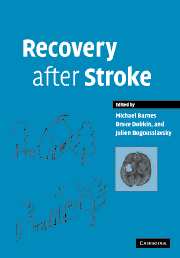Book contents
- Frontmatter
- Contents
- List of authors
- Preface
- 1 Stroke: background, epidemiology, etiology and avoiding recurrence
- 2 Principles of recovery after stroke
- 3 Regenerative ability in the central nervous system
- 4 Cerebral reorganization after sensorimotor stroke
- 5 Some personal lessons from imaging brain in recovery from stroke
- 6 Measurement in stroke: activity and quality of life
- 7 The impact of rehabilitation on stroke outcomes: what is the evidence?
- 8 Is early neurorehabilitation useful?
- 9 Community rehabilitation after stroke: is there no place like home?
- 10 Physical therapy
- 11 Abnormal movements after stroke
- 12 Spasticity and pain after stroke
- 13 Balance disorders and vertigo after stroke: assessment and rehabilitation
- 14 Management of dysphagia after stroke
- 15 Continence and stroke
- 16 Sex and relationships following stroke
- 17 Rehabilitation of visual disorders after stroke
- 18 Aphasia and dysarthria after stroke
- 19 Cognitive recovery after stroke
- 20 Stroke-related dementia
- 21 Depression and fatigue after stroke
- 22 Sleep disorders after stroke
- 23 Technology for recovery after stroke
- 24 Vocational rehabilitation
- 25 A patient's perspective
- Index
3 - Regenerative ability in the central nervous system
Published online by Cambridge University Press: 05 August 2016
- Frontmatter
- Contents
- List of authors
- Preface
- 1 Stroke: background, epidemiology, etiology and avoiding recurrence
- 2 Principles of recovery after stroke
- 3 Regenerative ability in the central nervous system
- 4 Cerebral reorganization after sensorimotor stroke
- 5 Some personal lessons from imaging brain in recovery from stroke
- 6 Measurement in stroke: activity and quality of life
- 7 The impact of rehabilitation on stroke outcomes: what is the evidence?
- 8 Is early neurorehabilitation useful?
- 9 Community rehabilitation after stroke: is there no place like home?
- 10 Physical therapy
- 11 Abnormal movements after stroke
- 12 Spasticity and pain after stroke
- 13 Balance disorders and vertigo after stroke: assessment and rehabilitation
- 14 Management of dysphagia after stroke
- 15 Continence and stroke
- 16 Sex and relationships following stroke
- 17 Rehabilitation of visual disorders after stroke
- 18 Aphasia and dysarthria after stroke
- 19 Cognitive recovery after stroke
- 20 Stroke-related dementia
- 21 Depression and fatigue after stroke
- 22 Sleep disorders after stroke
- 23 Technology for recovery after stroke
- 24 Vocational rehabilitation
- 25 A patient's perspective
- Index
Summary
Introduction
Functional improvement after permanent brain lesions results from changes in the remaining non-affected parts of the brain. The mechanisms involved may vary with post-ischemic time and the type and location of the lesion and can take the form of improved connectivity within individual neurons, modification of cortical representation areas, cortical maps, as well as non-synaptic transmission (Jenkins and Merzenich, 1987; Bach-y-Rita, 1990; Johansson and Grabowski, 1994; Nudo et al., 1996; Buonomano and Merzenich, 1998; Xerri et al., 1998; Nudo, 1999; Johansson, 2000; Hallett, 2001; Hickmott and Merzenich, 2002; Chen et al., 2002a; Keyvani and Schallert, 2002; Frost et al., 2003) There is also increasing evidence that astrocytes take an active part in brain plasticity, not only by their metabolic role and as producers of trophic factors but specifically by playing an active part in neural signaling and in synaptic plasticity (Jones and Greenough, 1996; Chvatal and Sykova, 2000; Araque et al., 2001; Ullian et al., 2001; Mazzanti and Haydon, 2003).
An important question is to what extent post-ischemic events can influence lesion-induced plasticity and improve functional restoration. That neuronal cortical connections can be remodeled was suggested half a century ago (Hebb, 1947). The effect of an activity-stimulating environment on brain function, biochemistry, and morphology has been well documented in the healthy as well as the lesioned brain (Bennett et al., 1964; Rosenzweig, 1966; Volkmar and Greenough, 1972; Will and Kelche, 1992; Kolb, 1995). Housing rats in an enriched environment (i.e. large cages allowing various types of activity) but not including forced training improved outcome after focal brain infarcts induced by proximal or distal ligation of the middle cerebral artery (MCA), even when the transfer to an enriched environment was delayed for 15 days after the arterial occlusion (Ohlsson and Johansson, 1995; Johansson, 1996). This chapter deals, first, with how post-ischemic housing conditions can influence functional outcome, gene expression, neuronal morphology, and interact with specific interventions in rats. Second, the current evidence that blocking neurite inhibitory factors may be a future therapy to promote axonal outgrowth is examined. Finally, current research on endogenous and exogenous neuronal replacement therapy is described and the relevance of animal studies for clinical stroke rehabilitation will be briefly discussed from a personal perspective.
- Type
- Chapter
- Information
- Recovery after Stroke , pp. 67 - 87Publisher: Cambridge University PressPrint publication year: 2005



